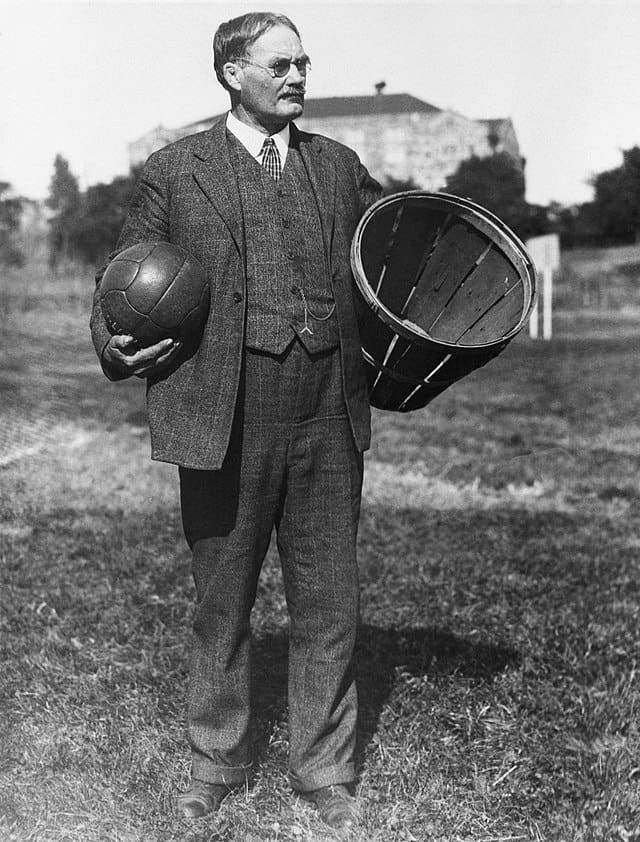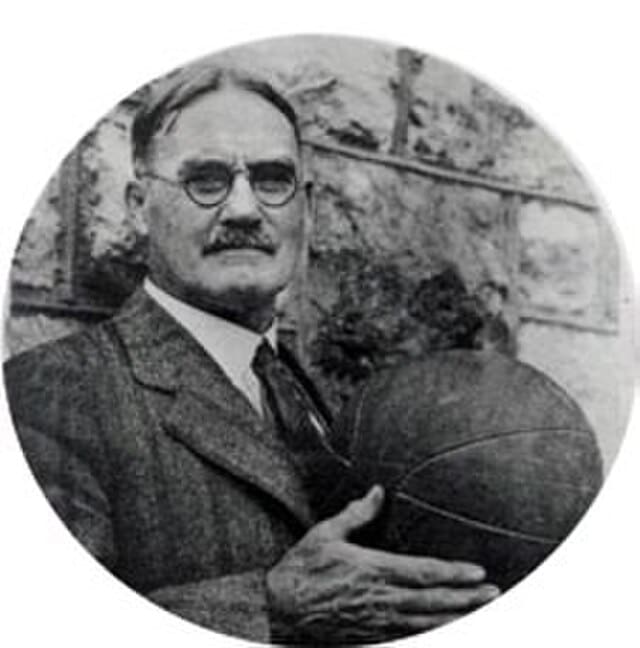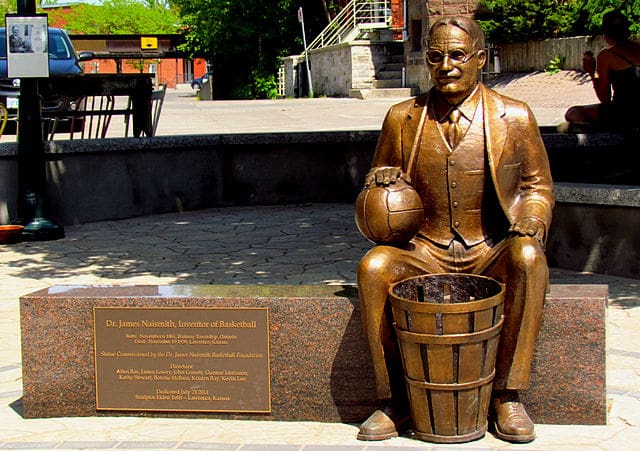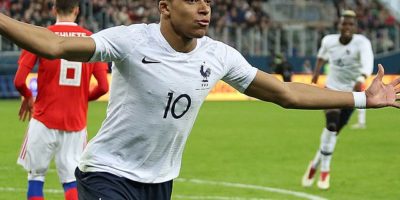10 Things You Didn’t Know About the Inventor of Basketball
Step onto the hardwood court to experience the symphony of athleticism and finesse where unwavering passion and lofty goals converge. Basketball, the lifeblood of sports, transcends borders and unifies fans everywhere with its exhilarating buzzer-beaters, hypnotic crossovers, and gravity-defying dunks.
This game has woven itself into the very fabric of human civilization, from the unrelenting quest for the greatness of icons like Jordan and LeBron to the stunning elegance of Curry’s three-point shooting prowess. It transcends sports into a fascinating tale of collaboration, tenacity, and pure enchantment as the squeak of shoes reverberates and the ball dances with unbelievable beauty.
James Naismith, a Canadian-American professor of physical education at Springfield College (now Springfield College) in Springfield, Massachusetts, was attempting to keep his gym class busy on a wet day in December 1891. During the lengthy New England winters, he looked for a challenging indoor game to keep his kids engaged and at the right levels of fitness. In the article are ten things you didn’t know about Jams Naismith.
Read On 10 Best Jewish Basketball Players Of All Time
1. Nismith had six professions

James Naismith Springfield College (Courtesy of Springfield College, Babson Library, Archives and Special Collections)., via Wikimedia Commons
James Naismith had a fascinating life and a wonderful personality. Three of the man’s six occupations are well-known, including basketball creator, Canadian-American physical instructor, and sports coach. James was a physician as well as a Christian priest.
It is important to remember that Naismith did not practice all of his vocations in a single nation or location. He may have practised chaplaincy in Canada, but he worked in the United States as a sports coach and as the man who created basketball.
2. Naismith founded the University of Kansas basketball program

Kansas Jayhawks Open Practice.jpg Phil Roeder from Des Moines, IA, USA, CC BY 2.0, via Wikimedia Commons
Just six years after he had drafted the first set of formal regulations for the game, Dr James Naismith joined the university, and the men’s basketball team had its start in 1898. Naismith was initially hired to lead the chapel and teach physical education, but he ended up being the basketball coach instead.
On February 3, 1899, the Jayhawks played their inaugural game against the Kansas City YMCA, which they lost 5-16. A week later, on February 10, they defeated the Topeka YMCA 31-6 to win their first game. On March 23, they faced off against Haskell, a college that is located approximately two miles to the southeast of the University of Kansas. They would end up 7-4 in their inaugural campaign.
As YMCAs around the country had played a crucial role in the formation of basketball, the majority of the university’s basketball games during the program’s early years were played against local YMCA teams. Haskell and William Jewell were two further rivals.
The team’s rivalries with Kansas State, subsequently known as the Sunflower Showdown and Missouri, afterwards known as the Border War (formally renamed to Border Showdown in 2004), had their start under Naismith. Ironically, Naismith was the only head coach in the history of the team to have a losing record (55-60).
Read On 20 Best Asian Basketball Players of All Time
3. Naismith mentored John McLendon
John B. McLendon Jr., an American basketball coach, holds the distinction of being the first African American head coach in any professional sport. He is also the first African American basketball coach at an institution with a preponderance of white students.
Throughout his career, he served as a coach at both the collegiate and professional levels, making a significant contribution to the growth of contemporary basketball. Both the National Collegiate Basketball Hall of Fame and the Naismith Memorial Basketball Hall of Fame have inducted him three times each.
Naismith’s coaching tree, whose two trunks are the well-known Phog Allen and Kansas native John McLendon, may be his greatest basketball legacy after creating the game. When Allen was the coach at KU in the 1930s, McLendon was a student there. McLendon never played for Allen despite trying out for the squad. From the time McLendon arrived in Kansas until after he had his degree, Naismith served as his mentor.
4. Naismith was orphaned at an early age
On November 6, 1861, Naismith was born to Scottish parents in Almonte, Canada West, Province of Canada (now a part of Mississippi Mills, Ontario, Canada). Despite claims to the contrary from various sources, Naismith never used a beginning “A” or a middle name. Someone in the University of Kansas administration inserted the “A”.
Naismith, who was orphaned at a young age, spent several years living with his aunt and uncle while attending elementary school at Bennies Corners, a town close to Almonte. In 1883, he received his diploma from Almonte High School in Almonte, Ontario, where he had previously attended. Naismith enrolled at McGill University in Montreal that same year and later graduated from there. Naismith taught at the institution until 1980.
5. Naismith was an ardent sportsman at McGill University

Mcgill University Arts Building.jpg No machine-readable author provided. Beltz~commonswiki assumed (based on copyright claims). via Wikimedia Commons
He was a gifted and adaptable athlete, representing McGill in football, lacrosse, rugby, soccer, and gymnastics despite being characterized as having a tiny build and standing at 5 feet 10+12 inches (1.791 m) and 178 pounds (81 kg). He fashioned some padding for his ears and played centre for the football squad.
He excelled in gymnastics, winning several Wicksteed medals. At the Presbyterian College in Montreal, Naismith received a diploma (1890) and a BA in physical education (1888). In 1938 and 1939, near the end of his career, he would be awarded honorary doctorates from both universities.
Read On 10 Things You Didn’t Know About the Inventor of Basketball
6. Naismith invented basketball while he was at Springfield College

Dr. James Naismith.jpg See page for author, Public domain, via Wikimedia Commons
Naismith served as the first director of athletics at McGill from 1888 to 1890 while also teaching physical education. After that, he departed Montreal to attend the YMCA International Training School in Springfield, Massachusetts.
Amos Alonzo Stagg was Naismith’s coach during his one year of football play at Springfield University when he also participated in the inaugural Madison Square Garden indoor collegiate football game and scored a touchdown.
Naismith was appointed as a full-time professor in 1891 after finishing the YMCA Physical Director training course that had brought him to Springfield. At the Springfield YMCA, Naismith had trouble managing a boisterous class that was forced to play indoor sports all winter long in the bitter New England weather.
Naismith was given 14 days to design an indoor game that would serve as a “athletic distraction” by Luther Gulick, who oversaw physical education there. Gulick specifically instructed Naismith to “make it fair for all players and not too rough” and demanded that the game not take up much space, help the school’s track athletes stay in shape, and not take up too much space.
Naismith used three primary ideas to help him come up with a new game. First, he examined the most well-liked sports at the time (rugby, lacrosse, soccer, football, hockey, and baseball); Naismith identified the risks associated with a ball and came to the conclusion that the large, soft soccer ball was the safest.
Second, he saw that running with the ball, dribbling it, or striking it led to the majority of physical collisions; hence, he concluded that passing was the only acceptable course of action. Finally, Naismith further decreased body contact by positioning the goal far above the players’ heads with the goal’s opening plane parallel to the floor. This made the goal impossible to defend.
This positioning made it necessary for the players to score goals by launching soft, lobbing shots, similar to those that were successful in his former favourite game, duck on a Rock. Naismith instructed the janitor to locate a couple of crates for this reason, but the janitor delivered him fruit baskets instead. Naismith gave this new sport the name “Basket Ball” and compiled his ideas into 13 fundamental guidelines.
7. Naismith had strong feelings against segregation
Since serving in France during World War I and at the US-Mexico border, Naismith developed “strong feelings against segregation,” and he worked to improve racial relations by taking little action.
He failed or was unable to recruit black players for Kansas’ varsity Jayhawks in the 1930s, but he did assist in arranging for their inclusion in the university’s swimming program. They had previously received automatic passing scores on a compulsory swimming exam without ever getting into the water, allowing the pool to stay completely white.
8. Naismith became the first basketball coach of the University of Kansas in 1898

James Naismith with a basketball.jpg Evdcoldeportes., Public domain, via Wikimedia Commons
Naismith was named the University of Kansas’ first basketball coach in 1898. Ironically, he is the only losing coach in Kansas history with a record of 55–60. Since Naismith coached Naismith Memorial Basketball Hall of Fame coach Phog Allen, who in turn coached Hall of Fame coaches Dean Smith, Adolph Rupp, and Ralph Miller who all coached future coaches as well, Naismith is at the start of a huge and illustrious coaching tree.
Amos Alonzo Stagg was mostly a football coach, but he also coached basketball for a year at Chicago and had numerous football players who were also basketball coaches, including Jesse Harper, Fred Walker, and Tony Hinkle. He also played basketball for Naismith in Springfield.
9. Naismith not only invented the game of basketball but wrote its original 13 rules
The laws and guidelines governing basketball play, officiating, equipment, and procedures are known as the basketball rules. While many of the fundamental laws are the same everywhere, there are some exceptions.
The National Basketball Association and NCAA, two of the most significant leagues or governing organizations in North America, create their own regulations. The International Basketball Federation (FIBA) Technical Commission also establishes regulations for international competition; the majority of leagues outside of North America use the whole FIBA ruleset.
The original basketball rules, regarded as the sport’s foundation document and penned by James Naismith in 1891, were auctioned off in December 2010 at Sotheby’s in New York. Josh Swade, a basketball-loving University of Kansas graduate, launched a campaign in 2010 to convince wealthy alumni to think about buying the document at auction in hopes of acquiring it and donating it to the university.
A rich investment banker and KU alumni named David G. Booth and his wife Suzanne Booth were finally convinced to participate in the auction by Swade. The winning bidders, the Booths, handed the document to the University of Kansas in exchange for a record-breaking US$4,338,500, the highest ever paid for a piece of sports memorabilia.
10. Naismith died of a brain haemorrhage

Naismith statue, Almonte.jpg D. Gordon E. Robertson, CC BY-SA 3.0, via Wikimedia Commons
After being married to his second wife Florence Kincaid on November 19 of the same year, Naismith had a significant cerebral hemorrhage and passed away at his Lawrence home nine days later. Age-wise, he was 78. Eight months after the NCAA Basketball Championship was established and eight months before it became one of the largest sporting occasions in North America, Naismith passed away.
Naismith is buried with his first wife at Lawrence’s Memorial Park Cemetery. At the age of 98, Florence Kincaid passed away in 1977. She is interred at Beloit, Kansas’ Elmwood Cemetery with her first husband, Frank B. Kincaid.
Dr James Naismith is eternally known as the creator of basketball and stands out as a visionary pioneer in the annals of sports history. He left an enduring legacy on the world of sports, motivating generations to embrace the wonder of the game he created with his imaginative energy and enthusiasm for physical education that cut across national boundaries.
Read On 25 Most Famous Australian Basketball Players
Planning a trip to Paris ? Get ready !
These are Amazon’s best-selling travel products that you may need for coming to Paris.
Bookstore
- The best travel book : Rick Steves – Paris 2023 – Learn more here
- Fodor’s Paris 2024 – Learn more here
Travel Gear
- Venture Pal Lightweight Backpack – Learn more here
- Samsonite Winfield 2 28″ Luggage – Learn more here
- Swig Savvy’s Stainless Steel Insulated Water Bottle – Learn more here
Check Amazon’s best-seller list for the most popular travel accessories. We sometimes read this list just to find out what new travel products people are buying.









